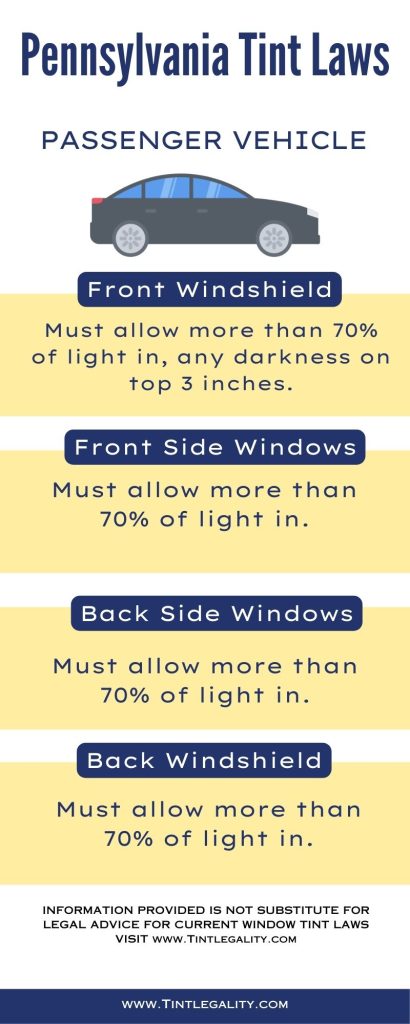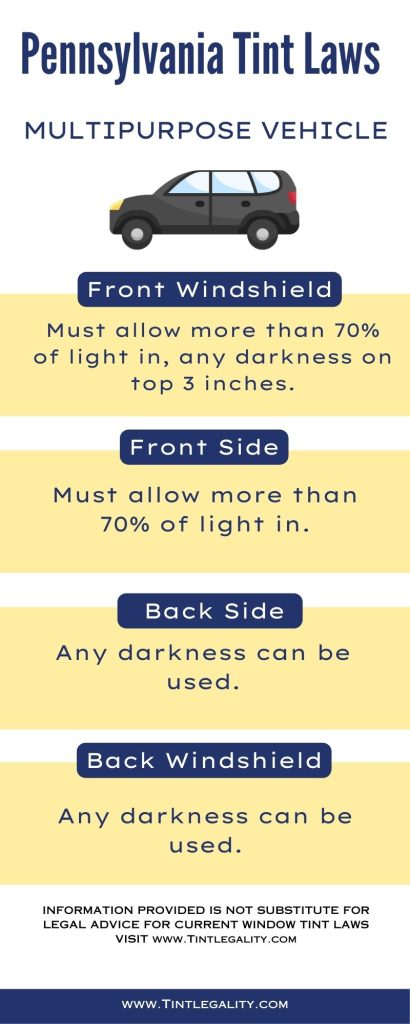Pennsylvania tint laws were first enacted in 1999, introducing a set of standards to govern the usage of window tint in the state.
This move established a specific guideline for the darkness, reflection, color, and other specifications of the tint permissible for use on car windows.
The percentage of light allowed to penetrate through the tinted film on the glass, known as Visible Light Transmission (VLT), was regulated differently depending on the type of vehicle – whether it’s a sedan or an SUV/van.
Regulations Regarding Window Tint in Pennsylvania
Window tint darkness and the amount of light allowed into the car are key elements governed by these laws.
| Window | Sedan | SUV/Van |
|---|---|---|
| Windshield | Must allow 70% of light | Must allow 70% of light |
| Front Side Windows | Must allow 70% of light | Must allow 70% of light |
| Back Side Windows | Must allow 70% of light | No restrictions |
| Rear Window | Must allow 70% of light | No restrictions |
| Reflection | No mirrored or metallic appearance | No mirrored or metallic appearance |
| Medical Exemptions | Allowed for special tints | Allowed for special tints |
| Color Restrictions | No specific banned colors | No specific banned colors |
| Side Mirrors | Required if back window is tinted | Required if back window is tinted |
Windshield
The law requires the windshield of any vehicle, be it a sedan or an SUV/van, to allow 70% light inside.
The top three inches of the windshield may have a darker tint, however.
Front Side Windows
Front-side windows follow the same rule as the windshield.
They must allow 70% light into the car, providing adequate visibility for the driver and preventing potential accidents.
Back Side Windows
Interestingly, the regulations for back-side windows differ between vehicle types.
While sedan backside windows must allow 70% light, there’s more flexibility for SUVs/vans, where any level of darkness can be used.
Rear Window
Similar to backside windows, sedans must allow 70% light through the rear window, while SUVs/vans can use any level of darkness.


Additional Regulations
Beyond light transmission and darkness, Pennsylvania tint laws also cover other aspects like reflection, color, and more.
Reflection
Window tints can reflect incoming light to reduce glare and heat. Pennsylvania allows a certain level of window reflection for all vehicles.
Both sedans and SUVs/vans should not have a mirrored or metallic appearance on any of their windows.
Medical Exemptions
Pennsylvania allows medical exemptions for special tints. Therefore, if you have a medical condition that requires a darker tint, you may be eligible for an exception.
Color Restrictions
There are no specific colors that are explicitly banned for window tints in Pennsylvania.
However, using colors that impair the driver’s visibility or distract other road users could lead to legal issues.
Side Mirrors
If a vehicle has its back window tinted, it is required to have dual side mirrors to compensate for the reduced rear visibility.
Exceptions to Legal Limits
While the state has precise rules, different counties within Pennsylvania may interpret the laws slightly differently, so it’s always recommended to double-check with your local DMV or law enforcement authorities.
Penalties for Breaking the Law
Violating Pennsylvania’s window tint laws can result in serious penalties, ranging from fines to other disciplinary actions.
Fines
Fines vary depending on whether it’s your first, second, or third conviction:
- First Conviction: This usually attracts a minimal fine, which serves as a warning to the violator.
- Second Conviction: The fine for a second conviction increases significantly, serving as a stronger deterrent.
- Third Conviction: A third conviction attracts the highest fine, sending a clear message about the importance of compliance with the law.
Other Penalties
Apart from fines, violators may also face other penalties such as community service or compulsory attendance at a driver improvement course.
In severe cases, the vehicle’s registration may be suspended, or the vehicle may be impounded until the illegal tint is removed.
It’s essential to note that these laws were created with safety as a top priority.
Compliance not only keeps you within the boundaries of the law but also contributes to the overall safety of Pennsylvania’s roads.
So remember, when tinting your windows, make sure you follow the Pennsylvania Tint Laws.
References:
https://en.wikipedia.org/wiki/Pennsylvania
https://www.dot.state.pa.us/Public/DVSPubsForms/BMV/BMV%20Fact%20Sheets/fs-sun.pdf
https://www.legis.state.pa.us/WU01/LI/LI/CT/HTM/75/00.045.024.000..HTM